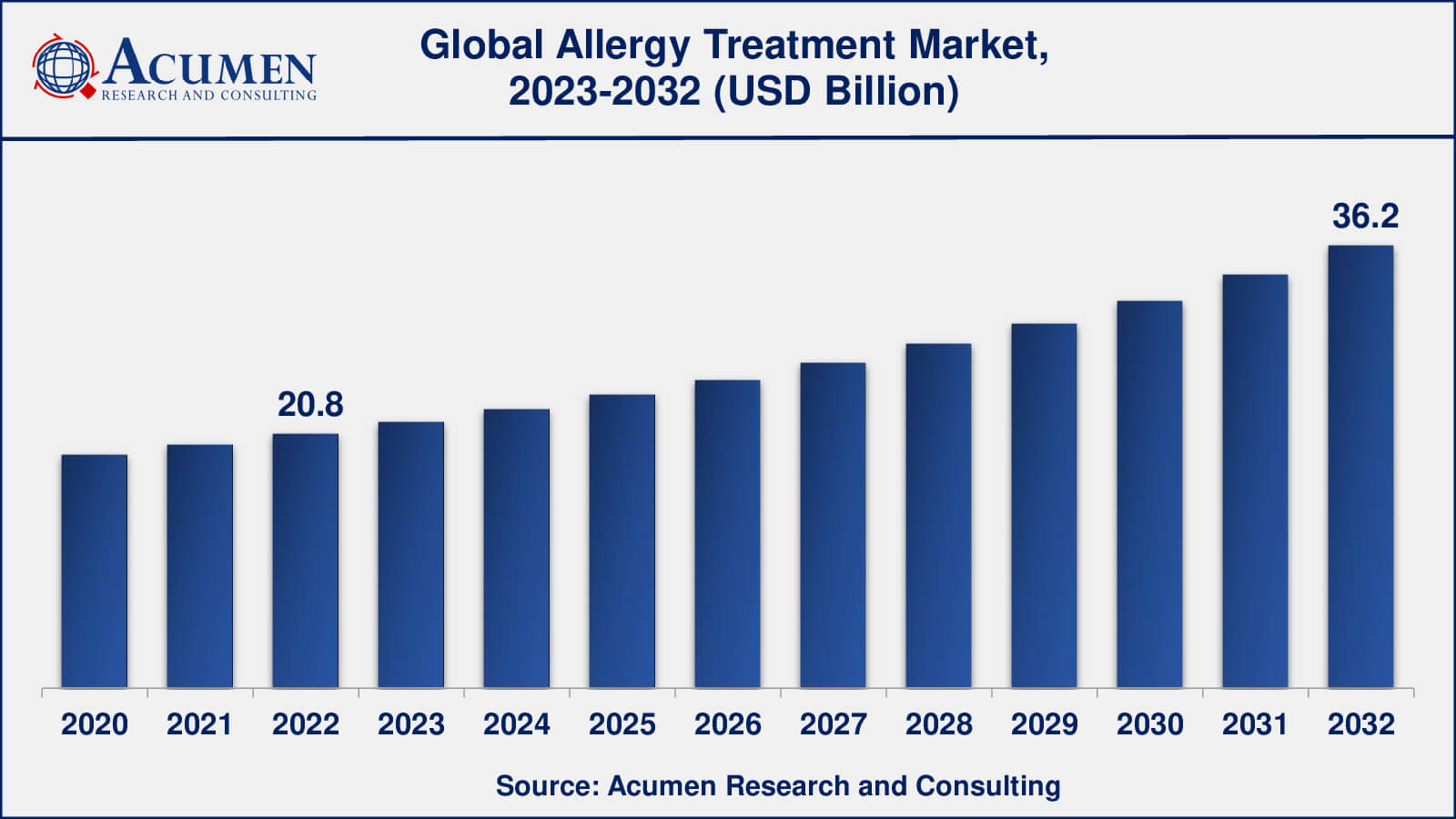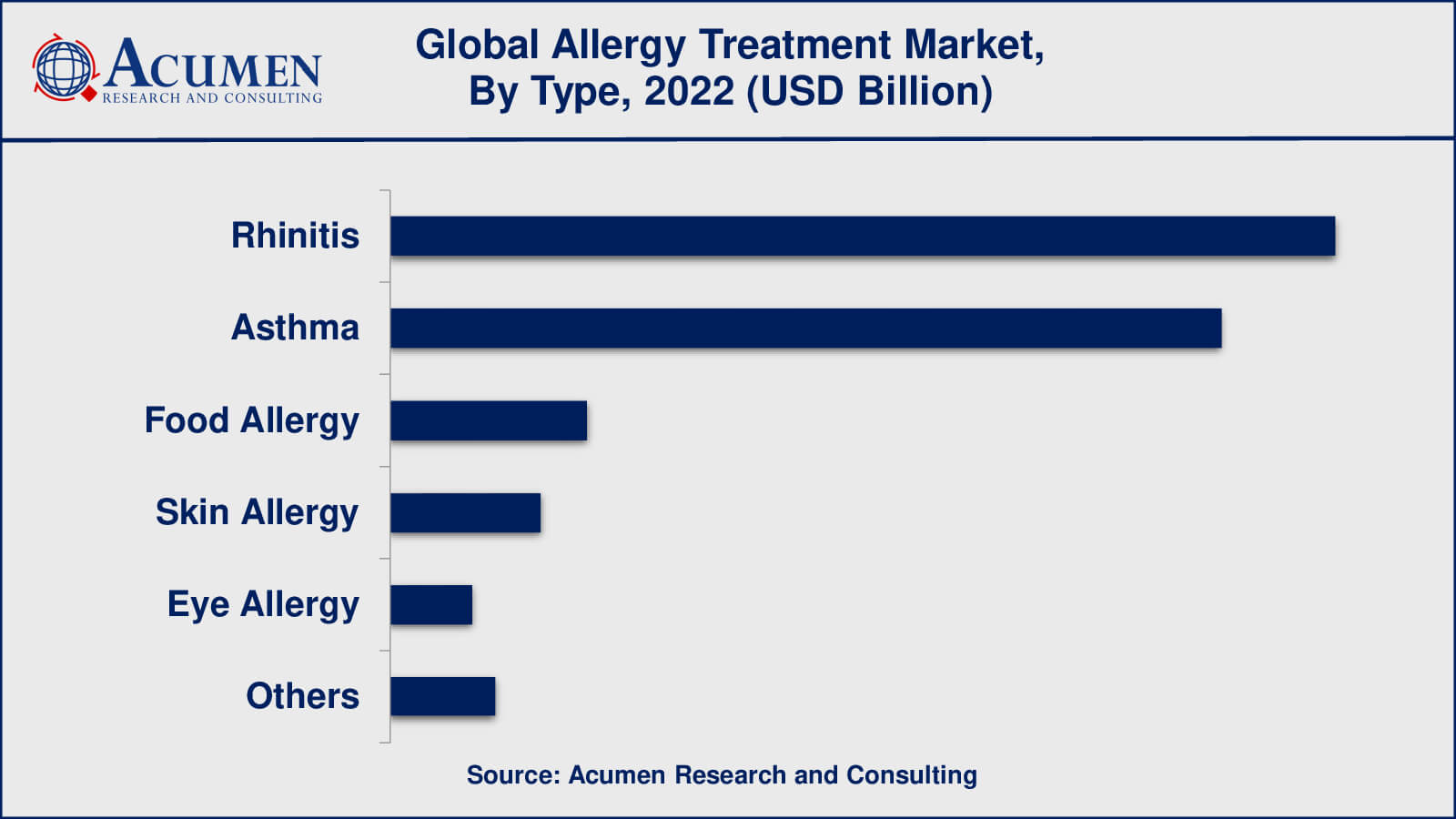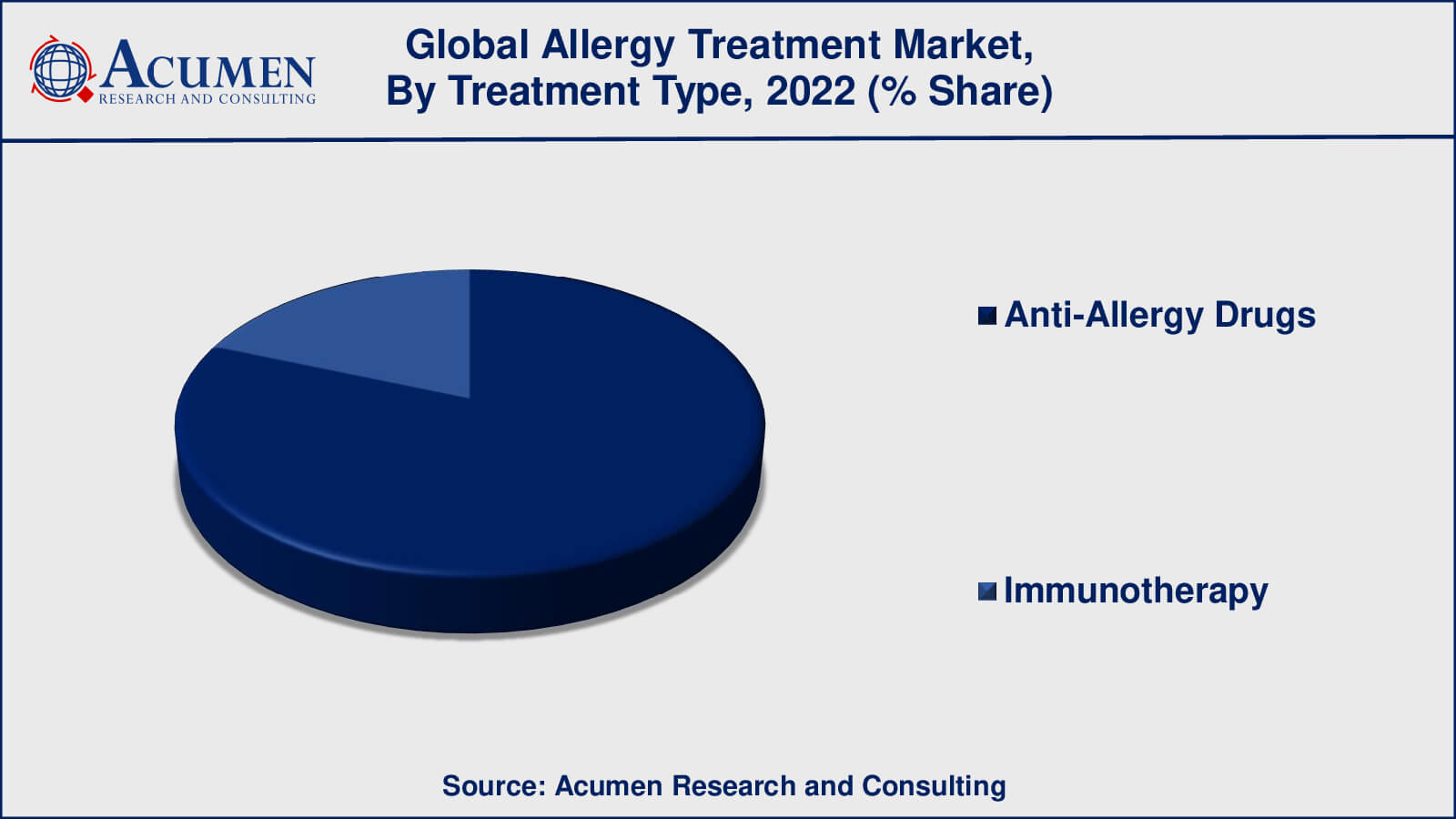Allergy Treatment Market Size - Global Industry, Share, Analysis, Trends and Forecast 2023 - 2032
Published :
Report ID:
Pages :
Format :
Allergy Treatment Market Size - Global Industry, Share, Analysis, Trends and Forecast 2023 - 2032
Report Coverage
- Industry Dynamics
- Market Size and Forecast Data
- Segment Analysis
- Competitive Landscape
- Regional Analysis with a Niche Focus on Country-Level Data
- High Level Analysis - Porter's, PESTEL, Value Chain, etc.
- Company Profiles of Key Players
- Option to Customize the Report As Per Your Specific Need
Request Sample Report
The Global Allergy Treatment Market Size collected USD 20.8 Billion in 2022 and is set to achieve a market size of USD 36.2 Billion in 2032 growing at a CAGR of 5.8% from 2023 to 2032.
Allergy Treatment Market Report Statistics
- Global allergy treatment market revenue is estimated to reach USD 36.2 billion by 2032 with a CAGR of 5.8% from 2023 to 2032
- North America allergy treatment market value occupied more than USD 8.1 billion in 2022
- Asia-Pacific allergy treatment market growth will record a CAGR of around 6% from 2023 to 2032
- Among type, the rhinitis sub-segment generated around 41% share in 2022
- Based on treatment type, the anti-allergy drugs generated more than US $ 4.4 billion revenue in 2022
- Increasing adoption of telemedicine is a popular allergy treatment market trend that fuels the industry demand

Heightened sensitivity of the immune system in the body is an allergy. Allergy generally occurs when any harmless foreign substances react with the immune system of the body. These harmless foreign substances are known as allergens. Various types of allergens that normally affect the immune system include dust mites, cockroaches, animal dander, mold, and pollens. As per the World Allergy Organization, approximately 30% to 40% population across the globe was affected by allergic conditions in 2011. Severe allergies such as allergic asthma can reduce the working function of an organ and can be a life-threatening problem in the case of some patients. The rising problem of allergy across the globe is anticipated to create a better opportunity for the allergy treatment market during the forecast period.
For in-depth research, the global allergy treatment market can be categorized on the basis of allergy type, treatment type, end user, and geography. Various types of allergy problems include eye allergy, rhinitis, asthma, and skin allergy among others. Based on treatment type, the market can be categorized into anti-allergy medicine and immunotherapy. The anti-allergy medicine can be further bifurcated into antihistamines, corticosteroids, decongestants, mast cell stabilizers, and others. The others segment include leukotriene, calcineurin, cromoglicate, and anti-lgE. Different categories of allergy treatment methods are used across various end-user segments such as hospitals, clinics, medical stores, homes, and others. Based on different geographies, the market is classified into Asia-Pacific, North America, Europe, Middle-East and Africa (MEA), and Latin America.

Global Allergy Treatment Market Dynamics
Market Drivers
- Increasing prevalence of allergies
- Rising healthcare expenditure
- Favorable regulatory environment
- Growing patient demand
Market Restraints
- High cost of allergy treatments
- Side effects of allergy treatments
- Limited efficacy of current treatments
Market Opportunities
- Increasing healthcare expenditure
- Emphasis on patient-centric care
Allergy Treatment Market Report Coverage
| Market | Allergy Treatment Market |
| Allergy Treatment Market Size 2022 | USD 20.8 Billion |
| Allergy Treatment Market Forecast 2032 | USD 36.2 Billion |
| Allergy Treatment Market CAGR During 2023 - 2032 | 5.8% |
| Allergy Treatment Market Analysis Period | 2020 - 2032 |
| Allergy Treatment Market Base Year | 2022 |
| Allergy Treatment Market Forecast Data | 2023 - 2032 |
| Segments Covered | By Type, By Treatment Type, Dosage Form, Distribution Channels, And By Geography |
| Regional Scope | North America, Europe, Asia Pacific, Latin America, and Middle East & Africa |
| Key Companies Profiled | Allergan Plc., Allergopharma GmbH & Co. KG, Allergy Therapeutics plc, Genentech Inc., F. Hoffmann-La Roche Ltd. (Genentech Inc.), GlaxoSmithKline plc, Johnson & Johnson, McNeil Consumer Healthcare, Novartis International AG, and Sanofi SA. |
| Report Coverage |
Market Trends, Drivers, Restraints, Competitive Analysis, Player Profiling, Covid-19 Analysis, Regulation Analysis |
Allergy Treatment Market Growth Factors
Globally, the increasing number of populations suffering from various types of allergies is the prime aspect forecasted to enhance the demand for various allergy treatment processes during the forecast period. Moreover, increasing environmental pollution is attributed to the growth of allergy problems across various regions. This, in turn, is anticipated to accelerate the growth of the allergy treatment process in the coming years. In addition, changes in food habits, increasing demand for advanced allergy treatment therapy, and rising investment in research and development activities to introduce advanced treatment into the market are some of the major factors expected to drive the market for allergy treatment at an exponential rate in the coming years. On the other hand, the huge cost required of immunotherapy for the treatment of allergies along with various side effects associated with immunotherapy and anti-allergy medicine are some of the major factors anticipated to deter the growth of the allergy treatment market during the forecast period.
Allergy Treatment Market Segmentation
The worldwide allergy treatment market is categorized based on type, treatment type, dosage form, distribution channel, and geography.
Allergy Treatment Market By Type
- Rhinitis
- Asthma
- Food Allergy
- Skin Allergy
- Eye Allergy
- Others

According to the allergy treatment market forecast, respiratory allergy segment, which includes rhinitis and asthma will account for the largest share in the coming years, followed by food allergy and skin allergy. Eye allergies and other allergies were minor market segments. It should be noted that the market share of each allergy type may vary depending on factors such as geography, demographics, and the prevalence of various types of allergies in a given population.
Allergy Treatment Market By Treatment Type
- Anti-Allergy Drugs
- Immunotherapy

According to an allergy treatment industry analysis, anti-allergy drugs accounted for the largest share of the allergy treatment market in 2022. Antihistamines, decongestants, corticosteroids, and leukotriene modifiers are examples of allergy medications. These medications are frequently used to treat allergy symptoms such as runny nose, sneezing, itching, and congestion. The report does, however, state that immunotherapy is expected to grow faster than anti-allergy drugs over the forecast period. Immunotherapy is a treatment that involves gradually exposing the patient to small amounts of the allergen in order to desensitise the patient's immune system to the allergen. This treatment is typically used for patients who have severe allergies or do not respond well to other treatments. Advances in technology, such as sublingual as well as oral immunotherapy, and a growing emphasis on personalised medicine are expected to drive immunotherapy growth.
Allergy Treatment Market By Dosage Form
- Oral
- Inhalers
- Intranasal
- Others
Intranasal among all dosage form occupied the utmost share in the market from 2023 to 2032. Intranasal products are directly injected into the nose, and include nasal sprays and nasal drops. These medications are frequently used to treat allergic rhinitis and other allergy-related nasal symptoms. The oral segment of the allergy treatment market, which includes tablets, capsules, and liquids, was the second largest segment. Oral medications are frequently used to treat a variety of allergy symptoms, including nasal symptoms, skin rashes, and gastrointestinal symptoms. The inhalers segment, which includes inhalation-administered products such as metered-dose inhalers and dry powder inhalers, was the market's third largest segment. These medications are frequently used to treat asthma and other allergic-related respiratory symptoms.
Allergy Treatment Market By Distribution Channel
- Hospital Pharmacies
- Retail Pharmacies
- Online Retailers
- Others
IN 2022, retail pharmacies were the highest revenue generating segment among all the distribution channels. Retail pharmacies include, among other things, chain pharmacies, independent pharmacies, and drugstores. These pharmacies are frequently the first point of contact for allergy patients, and they provide a wide range of over-the-counter and prescription allergy medications. The online retailers segment is expected to grow faster than other distribution channels during the forecast period, owing to increased e-commerce adoption and the convenience of purchasing medications online. Online retailers provide a wide range of allergy medications at competitive prices, making them an appealing option for many patients. Hospital pharmacies and other distribution networks, such as specialty pharmacies and mail-order pharmacies, occupied a smaller market share. The dominance of one distribution channel over another may vary depending on factors such as geography, demographics, and healthcare infrastructure.
Allergy Treatment Market Regional Outlook
North America
- U.S.
- Canada
Europe
- U.K.
- Germany
- France
- Spain
- Rest of Europe
Asia-Pacific
- India
- Japan
- China
- Australia
- South Korea
- Rest of Asia-Pacific
Latin America
- Brazil
- Mexico
- Rest of Latin America
The Middle East & Africa
- South Africa
- GCC Countries
- Rest of the Middle East & Africa (ME&A)
Allergy Treatment Market Regional Analysis
Geographically, North America held the largest market share in terms of revenue in respect of the allergy treatment market. The rising number of patients affected with different types of allergies such as respiratory allergy, eye allergy, and skin allergy among others coupled with the rapid development of healthcare infrastructure along with increasing demand for immunotherapy are the primary factors responsible for this region’s dominance. The allergy treatment market in North America is followed by Europe. However, the Asia-Pacific region is expected to emerge as a promising market in coming years owing to rising awareness towards technologically advanced immunotherapy treatment in line up with rising disposable income and increasing health consciousness among consumers. Furthermore, increasing investment from governments for rapid development of health care sector in this region is also predicted to drive the market for allergy treatment in Asia-Pacific.
Allergy Treatment Market Players
Increasing alliances among the key players operating in the allergy treatment market is another major factor augmenting the growth of allergy treatment market across the globe. Allergy Therapeutics, a leading pharmaceutical company in the U.K, acquired a Spanish company named Alerpharma S.A. in 2015 in order to expand their immunotherapy product portfolio. In the same year, Pfizer Inc. and Allergan plc merged for expanding their market share in the drug industry.
Some of the global allergy treatment companies profiled in the report include Allergan Plc., Allergopharma GmbH & Co. KG, Allergy Therapeutics plc, Genentech Inc., F. Hoffmann-La Roche Ltd. (Genentech Inc.), GlaxoSmithKline plc, Johnson & Johnson, McNeil Consumer Healthcare, Novartis International AG, and Sanofi SA.
Frequently Asked Questions
What was the market size of the global allergy treatment in 2022?
The market size of allergy treatment was USD 20.8 Billion in 2022.
What is the CAGR of the global allergy treatment market during forecast period of 2023 to 2032?
The CAGR of allergy treatment market is 5.8% during the analysis period of 2023 to 2032.
Which are the key players operating in the market?
The key players operating in the global market are Allergan Plc., Allergopharma GmbH & Co. KG, Allergy Therapeutics plc, Genentech Inc., F. Hoffmann-La Roche Ltd. (Genentech Inc.), GlaxoSmithKline plc, Johnson & Johnson, McNeil Consumer Healthcare, Novartis International AG, and Sanofi SA.
Which region held the dominating position in the global allergy treatment market?
North America held the dominating position in allergy treatment market during the analysis period of 2023 to 2032.
Which region registered the fastest growing CAGR for the forecast period of 2023 to 2032?
Asia-Pacific region exhibited fastest growing CAGR for allergy treatment market during the analysis period of 2023 to 2032.
What are the current trends and dynamics in the global allergy treatment market?
The current trends and dynamics in the allergy treatment industry include increasing prevalence of allergies, rising healthcare expenditure, and favorable regulatory environment.
Which type held the maximum share in 2022?
The rhinitis type held the maximum share of the allergy treatment market.?



